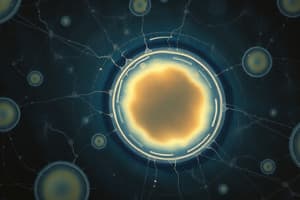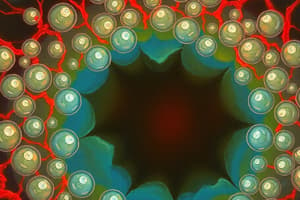Podcast
Questions and Answers
Which of the following are the three parts of a cell? (Select all that apply)
Which of the following are the three parts of a cell? (Select all that apply)
- Plasma membrane (correct)
- Nucleus (correct)
- Cell wall
- Cytoplasm (correct)
What is the structure of the plasma membrane?
What is the structure of the plasma membrane?
Membrane lipids, membrane proteins, carbohydrates
What is the function of the plasma membrane?
What is the function of the plasma membrane?
Acts as a gatekeeper (selective permeability)
What cannot pass through the plasma membrane?
What cannot pass through the plasma membrane?
What can pass through the plasma membrane?
What can pass through the plasma membrane?
What is tonicity?
What is tonicity?
What is an isotonic solution?
What is an isotonic solution?
What is a hypertonic solution?
What is a hypertonic solution?
What is a hypotonic solution?
What is a hypotonic solution?
What are organelles?
What are organelles?
What is the function of mitochondria?
What is the function of mitochondria?
What is the role of ribosomes?
What is the role of ribosomes?
What does the rough endoplasmic reticulum do?
What does the rough endoplasmic reticulum do?
What is the smooth endoplasmic reticulum responsible for?
What is the smooth endoplasmic reticulum responsible for?
What is the function of the Golgi apparatus?
What is the function of the Golgi apparatus?
What do lysosomes do?
What do lysosomes do?
What is the function of cytoskeletal organelles?
What is the function of cytoskeletal organelles?
What are microfilaments?
What are microfilaments?
What are intermediate filaments?
What are intermediate filaments?
What are microtubules?
What are microtubules?
What are cellular extensions?
What are cellular extensions?
What structures are found in the nucleus?
What structures are found in the nucleus?
What is the main function of the nucleus?
What is the main function of the nucleus?
What are cilia?
What are cilia?
What is flagella?
What is flagella?
What is the role of microvilli?
What is the role of microvilli?
What are nucleoli?
What are nucleoli?
What is the nuclear envelope?
What is the nuclear envelope?
What is chromatin?
What is chromatin?
What is mitosis?
What is mitosis?
What is interphase?
What is interphase?
What happens during early prophase?
What happens during early prophase?
What occurs during late prophase?
What occurs during late prophase?
What happens during metaphase?
What happens during metaphase?
What is anaphase?
What is anaphase?
What happens during telophase?
What happens during telophase?
What is cytokinesis?
What is cytokinesis?
What does mRNA (Messenger RNA) resemble?
What does mRNA (Messenger RNA) resemble?
What is rRNA (Ribosomal RNA)?
What is rRNA (Ribosomal RNA)?
What does tRNA (Transfer RNA) do?
What does tRNA (Transfer RNA) do?
What is transcription?
What is transcription?
What is a diploid cell?
What is a diploid cell?
What is a haploid cell?
What is a haploid cell?
How many chromosomes do human somatic cells contain?
How many chromosomes do human somatic cells contain?
What does the central dogma state?
What does the central dogma state?
What is DNA?
What is DNA?
What is translation?
What is translation?
Flashcards are hidden until you start studying
Study Notes
Structure and Function of Cells
- Cells consist of three main parts: Plasma membrane, Cytoplasm, and Nucleus.
- Plasma membrane components include membrane lipids, membrane proteins, and carbohydrates.
- Functions as a selective barrier, allowing certain substances to pass through while blocking others.
Membrane Permeability
- Large polar molecules and charged substances cannot pass through the plasma membrane.
- Small gases, non-polar substances, and small polar molecules like water can freely pass through.
Tonicity and Solutions
- Tonicity measures a solution's ability to affect cell volume by altering water concentration.
- Isotonic solutions maintain cell size and shape due to equal concentrations of solutes and water.
- Hypertonic solutions cause cells to lose water and shrink, having higher solute concentrations outside.
- Hypotonic solutions make cells swell and potentially burst, containing lower solute concentrations than inside cells.
Organelles and Their Functions
- Organelles are specialized compartments within cells that perform distinct functions.
- Mitochondria are known as the powerhouse of the cell, where ATP synthesis occurs.
- Ribosomes are the sites of protein synthesis.
- Rough Endoplasmic Reticulum (Rough ER) modifies and transports proteins; it is studded with ribosomes.
- Smooth Endoplasmic Reticulum (Smooth ER) is involved in lipid synthesis and detoxification processes.
Golgi Apparatus and Lysosomes
- The Golgi apparatus sorts and processes proteins, consisting of stacked smooth sacs and vesicles.
- Lysosomes digest intracellular debris, acting as the cell's garbage disposal.
Cytoskeletal Structures
- Cytoskeletal organelles include microfilaments (actin strands), intermediate filaments (tough protein fibers), and microtubules (hollow tubes of tubulin) which provide structural support.
Cellular Extensions
- Cellular extensions enhance motility or increase surface area; examples include cilia, flagella, and microvilli.
- Cilia are short and create a unidirectional current for moving substances across surfaces.
- Flagella are longer and propel cells, such as sperm cells.
- Microvilli increase surface area, aiding in absorption.
Nucleus
- The nucleus is the control center of the cell, with a structure including the nuclear envelope, chromatin, and nucleolus.
- The nuclear envelope separates nucleoplasm from cytoplasm and regulates substance passage.
Cell Cycle and Mitosis
- Mitosis is the nuclear division process that results in two daughter nuclei.
- Interphase is the cell's phase of normal activity and growth.
- Prophase involves chromatin condensation into chromosomes; late prophase sees nuclear envelope fragmentation.
- Metaphase aligns chromosomes at the cell's equator, with centrosomes at opposite poles.
- Anaphase marks the separation of chromatids, becoming individual chromosomes.
- Telophase begins when chromosomal movement stops, followed by cytokinesis which divides the cytoplasm into two identical daughter cells.
RNA Types and Genetic Processes
- Messenger RNA (mRNA) serves as a copy of DNA for protein synthesis.
- Ribosomal RNA (rRNA) is a component of ribosomes.
- Transfer RNA (tRNA) transports amino acids to ribosomes during protein synthesis.
- Transcription is the process where DNA is transcribed to mRNA, tRNA, and rRNA.
- Diploid cells contain a full set of chromosomes (46 total).
- Haploid cells have one chromosome from each pair.
- Human somatic cells have 46 chromosomes or 23 pairs.
- The Central Dogma of molecular biology describes the flow of genetic information: DNA → RNA → Protein.
Protein Synthesis
- Translation is the process of converting mRNA's nucleotide language into amino acid sequences for protein formation.
Studying That Suits You
Use AI to generate personalized quizzes and flashcards to suit your learning preferences.




